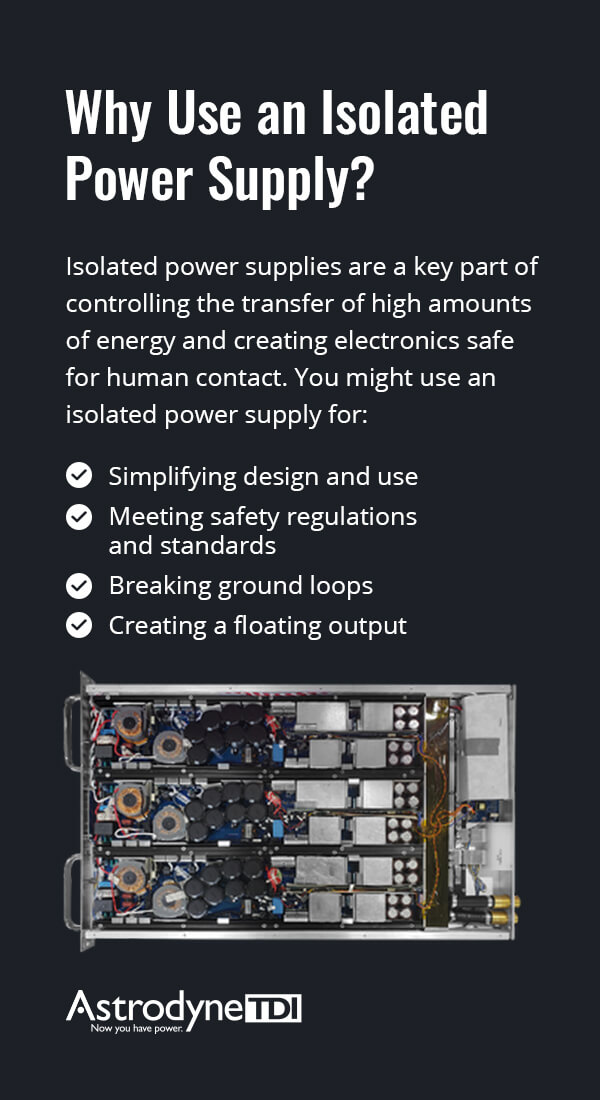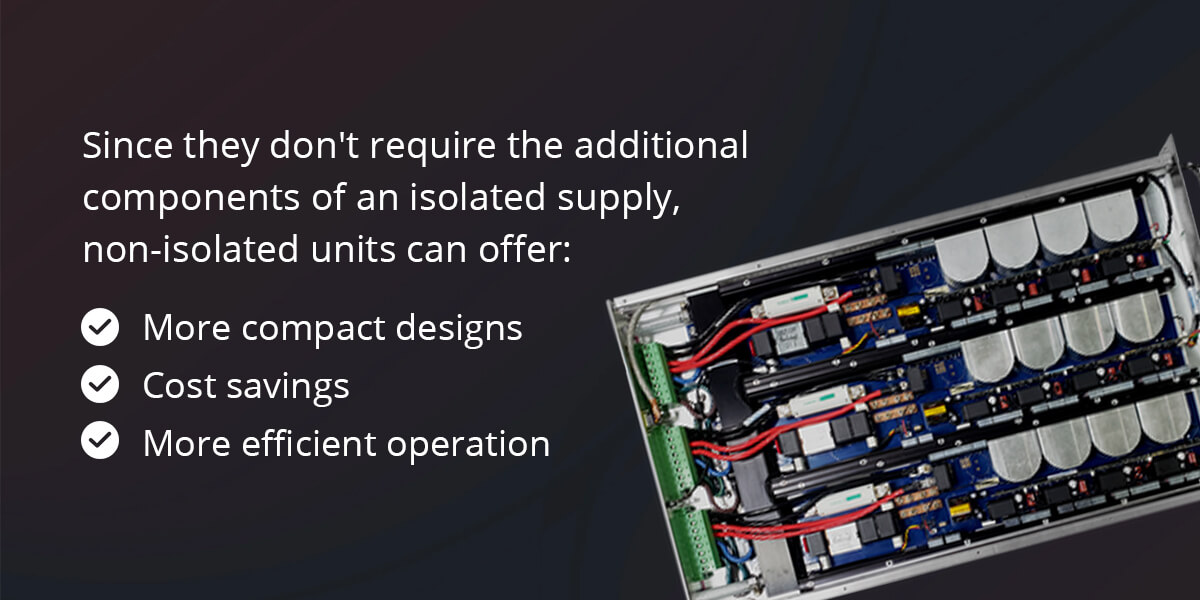RESOURCES
Isolated vs. Non-Isolated Power Supplies
In a highly digital world, it's easy to take the safety of electronics for granted. We can hold phones in our pockets, get hooked up to medical equipment, and ride in planes without being shocked, even though these systems ultimately connect to high-voltage power sources. We owe much of that safety to isolation.
Isolation is a safety mechanism in electronics that prevents us from contacting high-voltage currents. It works like a dam to halt the fast flow of current and keep it controlled, so even untrained users can safely interact with electronics and avoid the risk of electric shock. Although isolation is vital in some applications, it can add unnecessary costs and complexities in others.
Choosing between an isolated and non-isolated power supply depends on several factors. Let's explore isolated vs. non-isolated systems and how to choose the right one for your application.
What Is an Isolated Power Supply?
An isolated power supply is separated from other circuits in a system. Being isolated protects users and downstream components from large voltage and current surges from the input power source. Insulating materials, such as electrical tape, a hard plastic housing or even a few centimeters of air, help prevent the current from reaching the person. Devices like transformers or coupled inductors transfer power in a controlled manner without a direct electrical connection.
A transformer, for example, is commonly used for power transfer and magnetically couples the energy from one circuit to another without any contact. An isolated power supply can also transmit signals by using techniques that maintain electrical isolation between the primary and secondary sides. Adding power factor correction (PFC) and regulator stages at other points can help keep output currents safe and stable.
Many devices need isolated power supplies to meet industry regulations that help reduce the risk of shock. For example, even with high-voltage units, the user may need to interact with the power supply's output stage, such as plugging or unplugging wires or adjusting control settings. Since isolation separates the output from the input, the user's risk of shock is much lower. In many cases, the reduction is enough to allow untrained users to interact with the power supply.
Isolation capabilities can break down over time, so it's important to pay attention to specifications and maximum voltages to keep isolation systems in good condition, especially in high-voltage applications.
Why Use an Isolated Power Supply?
Isolated power supplies are used to provide electrical power while maintaining electrical isolation between the input and output. They are a key part of controlling the transfer of high amounts of energy and creating electronics safe for human contact. You might use an isolated power supply for:
- Simplifying design and use: Many devices, like computers and TVs, have sensitive components that benefit from a more controlled energy flow. While they require more components, isolated power supplies can help designers and engineers easily meet these demands for controlled currents. They can also simplify use for the final product by eliminating special training requirements.
- Meeting safety regulations and standards: Government and industry organizations — such as the International Electrotechnical Commission (IEC), the International Organization for Standardization (ISO), and Underwriters Laboratories (UL) — often require isolation for certain products. These regulations may outline certain types or grades of insulation depending on risk and product type.
- Breaking ground loops: Ground loops form when two devices connect to both each other and the ground through different paths. They can disrupt the current flow and create noise or interference. Isolation can break up these loops and is often used for circuits that are sensitive to noise.
- Creating a floating output: Floating outputs are ungrounded and do not reference another output. Many products use floating outputs to add safety. Others, like aircraft, need floating outputs because a ground connection is impossible. By connecting one terminal to another circuit node to fix it to that voltage, floating outputs can also invert or shift the output along the circuit.

What Is a Non-Isolated Power Supply?
As you may have guessed, a non-isolated power supply does not have insulation to isolate the circuit. Both the input and output share a common electrical connection, so the current can flow between them through a single circuit. Since the two are connected, the output of a non-isolated power supply could carry hazards from the input, like high voltage, to the user.
Non-isolated systems can still be isolated from the user to prevent electrical shock. Take a hair dryer, for instance. It has a heater and a fan, both connected to electrical power without any isolation between them. However, they are isolated from the user through the plastic body of the hair dryer and other components. You can also have truly non-isolated components that don't contact the human body at all, like electrical motors in pumps and fans.
While non-isolated power supplies have other benefits, they may require alternative means of protection to prevent human contact. In some cases, only trained technicians can handle non-isolated power supplies since they understand safety requirements. Other times, the product will need to accommodate additional features like safety barriers or prevent the system from connecting to others that could cause damage or be damaged. For example, an industrial power supply shouldn't be compatible with a phone charger.
Why Use a Non-Isolated Power Supply?
While they lack the safety features of an isolated power supply, non-isolated power supplies offer other benefits, like advantages in speed and design. When board-mounted near the load, they may be called point-of-load power supplies, which help reduce high incoming voltages to lower ones. Placing a non-isolated power supply downstream from an isolated power supply can help alleviate some safety concerns.
Since they don't require the additional components of an isolated supply, non-isolated units can offer:
- More compact designs: Non-isolated systems don't need components like transformers and optocouplers, which allow designers to make smaller power supplies. They may be necessary when space is tight. Non-isolated power supplies also tend to offer higher switching frequencies, which can make some parts, like capacitors and magnetic components, smaller, further reducing the unit's size.
- Cost savings: Without those extra components, a non-isolated power supply can be more affordable. A significant reason for the lower costs comes from reduced component count and complexity. Transformers must often be custom-built, while inductors are easier to buy off the shelf. High levels of insulation can also increase the costs of an isolated power supply, which non-isolated units don't need.
- More efficient operation: Non-isolated power supplies also have an efficiency advantage. The lack of isolation barriers provides direct control and monitoring of the output, which enables better performance and regulation. Plus, since they're smaller, non-isolated power supplies can sit closer to the load, which helps minimize adverse effects on the transmission line.
While this increased performance can be tempting, the end user's safety is critical. As with most aspects of electrical engineering, you must balance these benefits with the characteristics of your application, such as available space, allowable interference, efficiency requirements, potential safety risks and budget.

What Is the Difference Between Isolated and Non-Isolated Power Supplies?
Both isolated and non-isolated power supplies are essential elements in many electronic devices, from consumer laptops and blenders to industrial manufacturing equipment, medical imaging machines, and mission-critical military vehicles. The right one for your application depends on a range of factors. Here are some primary areas where isolated and non-isolated power supplies differ.
Safety and Compliance
Isolated and non-isolated power supplies support different use cases. An isolated power supply is typically used where the safety of non-experts, such as consumers, patients, and untrained employees, would otherwise be at risk. They may require additional certification or verifications, but they can help you avoid instances of injury or damage that could hurt your bottom line and your reputation.
Using an isolated power supply will call for a slightly larger and less efficient system, so it may not be appropriate for particularly small installations or those that need maximum efficiency.
However, non-isolated power supplies can offer speed and efficiency, but they may require other precautions to prevent safety hazards. As with our hair dryer example, the overall system could be isolated from the user. Without appropriate safety mechanisms, only trained technicians should interact with the power supply.
Consider any applicable safety standards your product must meet. Even if you don't have standards to address, isolation could help you mitigate risk and improve the overall safety of the product. Weigh the necessity of isolation with information on the typical user and the power supply's environment.
Cost
An isolated system will typically increase the cost of the power supply thanks to the need for a transformer and other components. If you have a tight budget, you may need to think about where else you can reduce costs or whether a non-isolated option is viable. If you have a healthy budget and can handle the added complexity, an isolated system can boost safety and reduce noise.
Size
The additional parts involved make isolated systems larger, while non-isolated power supplies may take up less room. In tight quarters, an isolated system could be too bulky for your application. It adds some complexity to the design process, and other changes may be necessary to compensate for the extra size. However, isolation can add flexibility by allowing you to break ground loops and make floating outputs.
Efficiency
Transformer losses in an isolated system can reduce its efficiency. For applications with small efficiency thresholds, this loss could be enough to make isolation inappropriate. If you need isolation, you may need to pay attention to additional heat generation or energy costs to ensure a high-performing system.
Noise
Isolated power supplies can help reduce noise in circuits that are sensitive to it by separating the circuits. Breaking ground loops, for instance, may limit noise and preserve signal quality in some applications.
How Do I Know if My Power Supply Is Isolated or Non-Isolated?
Depending on their design and application requirements. The difference lies in whether there is an electrical isolation between the input and output, typically achieved using a transformer. You can tell if your existing power supply is isolated with one of the following methods:
- Check the voltage: Connect a value resistor between your input and output points and measure the voltage. If you see any voltage, the power supply is not isolated.
- Check your schematics: If you still have the schematics for the power supply, they should indicate whether the unit is isolated or non-isolated.
- Ask the manufacturer: Look online or contact the manufacturer with information about your power supply. Have the model number ready, and they should be able to tell you if your unit is isolated.
- Visually inspect the power supply: Isolated systems may have an icon of a square within a square that shows the device is double insulated. If you just received a power supply, check the packaging for shock warnings or protective plastic housings, both of which can point to a non-isolated system.
Until you know for sure, treat your power supply as though it is not isolated. Use all appropriate precautions and do not apply high voltages to it.
How to Choose the Right Power Supply
Remember, many different factors will affect how a power supply will meet your needs. Consider how the device will be used, the characteristics of the power source, what standards you may need to meet and any design limitations you may have, such as size or budget restrictions.
You may want to use an isolated power supply if:
- You're converting a high current from AC to DC or DC to DC
- You must meet safety regulations in certain industries, such as in medical, IT or audiovisual applications
- You need to break ground loops or eliminate noise
- You want to create floating outputs for specific applications and products, such as detectors for mass spectrometers or filaments for anode-grounded X-ray tubes
However, you might want to use a non-isolated power supply if:
- You're working with small circuit boards, circuits or chips that won't generate much current or don't operate at high voltages
- The user won't interact with the system in a way that presents a high risk of shock
- Efficiency, compactness or affordability is a priority
You may need to weigh demands for safety or technical requirements with the need for efficiency, size and costs. Isolation can play a significant role in the design of a power supply, so keep this technology in mind from the start. Pay attention to how your users will interact with the product and how other parts of your system, such as upstream components and available space, will affect or be affected by an isolated or non-isolated power supply.
Find Power Supplies for Any Application From Astrodyne TDI
Neither an isolated nor non-isolated power supply is better than the other. The best choice depends on the many factors involved in the design and use of the unit. Here at Astrodyne TDI, we have power supplies to fit your needs and the expertise necessary to help you find the right ones.
Our entire line of low-power units and most of our high-power units are isolated. Non-isolated systems include our full line of EMI filters and our non-isolated LiquaBlade™ products. If you're not sure what's best for your application, our knowledgeable team can help. Reach out to us today to request a quote or talk with an expert to find the ideal power supply for your project.


